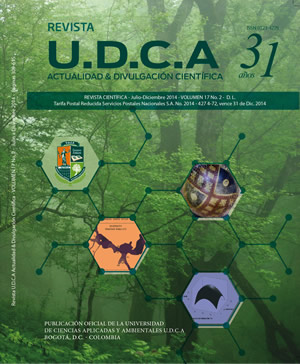Evaluación de parámetros de calidad físico- química, microbiológica y sensorial en tomate deshidratado comercial (Lycopersicum esculentum)
Quality evaluation of physico-chemical, microbiological and sensorial parameters of dried tomato (Lycopersicum esculentum)
Contenido principal del artículo
Resumen
El tomate es una de las hortalizas más importantes en el mundo, por su nivel de producción y de consumo. Debido a su naturaleza perecedera tiene un difícil manejo postcosecha, lo que ocasiona pérdidas importantes de producto durante su almacenamiento y comercialización, razón importante para considerar métodos de conservación, como la deshidratación y así extender su vida útil. Este trabajo tuvo como objetivo establecer los parámetros fisicoquímicos, microbiológicos y sensoriales, que influyen en la calidad de muestras comerciales de tomate deshidratado. Para el estudio, se utilizaron muestras del mercado local y se analizaron los parámetros humedad, actividad de agua y pH, mediante las técnicas estandarizadas de la AOAC; color, utilizando el sistema CIE, con coordenadas L*a*b* y análisis de textura, aplicando la metodología del TPA (Texture Profile Analysis). Adicionalmente, se verificó la calidad microbiológica del producto, según la metodología sugerida por el INVIMA; finalmente, se hizo una prueba sensorial hedónica dirigida a consumidores, para correlacionar con los análisis instrumentales. Se obtuvo que el pH no tiene influencia en el tomate deshidratado comercial y que el color y la textura, además de presentar diferencias significativas entre muestras (p<0.05), son los parámetros más importantes en cuanto a la calidad sensorial del tomate, ya que el consumidor busca una color igual al tomate fresco y como producto deshidratado prefiere un producto blando y con fracturabilidad alta.
Descargas
Datos de publicación
Perfil evaluadores/as N/D
Declaraciones de autoría
- Sociedad académica
- Universidad de Ciencias Aplicadas UDCA
- Editorial
- Universidad de Ciencias Aplicadas y Ambientales U.D.C.A
Detalles del artículo
Referencias (VER)
AKDENIZ, B.; KAVAK, D.D.; BAĞDATLIOĞLU, N. 2012. Use of factorial experimental design for analyzing the effect of storage conditions on color quality of sundried tomatoes. Sci. Res. Essays. 7(4):477-489.
AOAC. 2002. Official Methods of Analysis. Association of Analytical Chemists. 920.151. total solids in fruit and fruit products.
ASHEBIR, D.; JEZIK, K.; WEINGARTEMANN, H.; GRETZMACHER, R. 2009. Change in color and other fruit quality characteristics of tomato cultivars after hot-air drying at low final-moisture content. Int. J. Food Sci. Nutr. 60(7):308-315.
BARREIRO, J.A.; MILANO, M.; SANDOVAL, A.J. 1997. Kinetics of colour change of double concentrated tomato paste during thermal treatment. J. Food Eng. 33(3-4):359-371.
BATU, A. 2004. Determination of acceptable firmness and colour values of tomatoes. J. Food Eng. 61(3):471-475.
BROOKS, M.S.; GHALY, A.E.; ABOU EL-HANA, N.H. 2008. Effect of osmotic pre-treatment on the airdrying behavior and quality of plum tomato pieces. Int. J. Food Eng. 4(5):1-24.
CHANG, C.-H.; LIN, H.-Y.; CHANG, C.-Y.; LIU, Y.-C. 2006. Comparisons on the antioxidant properties of fresh, freeze-dried and hot-air-dried tomatoes. J. Food Eng. 77(3):478-485.
GBX. 2008. Fast-lab water activity meter. Disponible desde Internet en: http://www.gbxonline.com/Eng_AW.html (con acceso 04/11/2012).
HEREDIA, A.; BARRERA, C.; ANDRÉS, A. 2007. Drying of cherry tomato by a combination of different dehydration techniques. Comparison of kinetics and other related properties. J. Food Eng. 80(1):111-118.
HOSSAIN, M.A.; AMER, B.M.A.; GOTTSCHALK, K. 2008. Hybrid solar dryer for quality dried tomato. Drying Techn. 26(12):1591-1601.
ICONTEC. 1999. NTC 4592. Productos de frutas y verduras. determinación del pH. Instituto colombiano de normas tecnicas. Tecnicas (Ed.). Bogotá.
IDAH, P.A.; ADERIBIGBE, B.A. 2007. Quality changes in dried tomatoes stored in sealed polythene and open storage Systems. Leonardo Electr. J. Practices Techn. 6(10):1-6.
INVIMA. 1998. Manual de técnicas de análisis para el control de calidad microbiológico de alimentos para consumo humano. Bogotá (Colombia).
KEK, S.P.; CHIN, N.L.; YUSOF, Y.A. 2013. Direct and indirect power ultrasound assisted pre-osmotic treatments in convective drying of guava slices. Food Biopr. Proces. 91(4):495-506.
KHAZAEI, J.; CHEGINI, G.-R.; BAKHSHIANI, M. 2008. A novel alternative method for modeling the effects of air temperature and slice thickness on quality and drying kinetics of tomato slices: superposition technique. Drying Techn. 26(6):759-775.
GILBERT, R.J.; DE LOUVOIS, J.; DONOVAN, T.; LITTLE, C.; NYE, K.; RIBEIRO, C.D.; RICHARDS, J.; ROBERTS, D.; BOLTON, F.J. (PHLS Advisory Committee for Food and Dairy Products). 2000. Guidelines for the microbiological quality of some ready-to-eat foods sampled at the point of sale. Commun. Dis. Public Health. 3:163-167.
LOZANO, J.E.; IBARZ, A. 1997. Colour changes in concentrated fruit pulp during heating at high temperatures. J. Food Eng. 31(3):365-373.
MINISTÉRIO DA SAÚDE BRASIL. 1978. Resolução - CNNPA n° 12, de 1978 Frutas secas ou dessecadas (Vol. 12-1978, p.75). Brasil: Agência Nacional de Vigilância Sanitária.
MINISTERIO DE LA PROTECCIÓN SOCIAL DE COLOMBIA. 2011. Proyecto de resolución Frutas. Bogotá. p.2.
MINISTERIO DE SALUD DEL PERÚ. 2003. Norma sanitaria que establece los criterios microbiológicos de calidad sanitaria e inocuidad para los alimentos y bebidas de consumo humano De los grupos de alimentos y criterios microbiológicos (Vol. 615-2003, p.24).
MONSALVE, J.; MACHADO, M. 2007. Evaluación de dos metodos de deshidratación del tomate (Lycopersicom esculentum Mill) variedad manzano. Multiciencias. 7(3):256-265.
MONTGOMERY, D. 2002. Diseño y analisis de experimentos (2a ed.). Mexico D.F. Wiley Editors. 686p.
MORENO-GUARIN, D.; SIERRA-HOYOS, H.; DIAZ-MORENO, C. 2012. Color y textura, caracteristicas asociadas a la calidad del tomate deshidratado. Vitae. 19:201-203.
OLORUNDA, A.O.; AWORH, O.C.; ONUOHA, C.N. 1990. Upgrading quality of dried tomato: effects of drying methods, conditions and pre-drying treatments. J. Sci. Food Agr. 52(4):447-454.
PÉREZ, M.; BELMONTE, S.; MARTÍNEZ, J. 1998. Estudio microbiológico de los alimentos elaborados en comedores colectivos de alto riesgo. Rev. Esp. Salud Publica. 72(1):67-75.
POLENTA, G.; LUCANGELI, C.; BUDDE, C.; GONZÁLEZ, C.B.; MURRAY, R. 2006. Heat and anaerobic treatments affected physiological and biochemical parameters in tomato fruits. LWT - Food Sci. Techn. 39(1):27-34.
RATTI, C. 2001. Hot air and freeze-drying of high-value foods: a review. J. Food Eng. 49(4):311-319.
RATTI, C. (Ed.). 2009. Advances in food Dehydration (1a ed.): Taylor and Francis group. 477p.
SHI, J.; MAGUER, M.L.; KAKUDA, Y.; LIPTAY, A.; NIEKAMP, F. 1999. Lycopene degradation and isomerization in tomato dehydration. Food Res. Int. 32(1):15- 21.
SHIN, S.; BHOWMIK, S.R. 1995. Thermal kinetics of color changes in pea puree. J. Food Eng. 24(1):77-86.
SIDEL, J.L.; MOSKOWITZ, H.R. 1971. Magnitude and hedonic scales of food acceptability. J. Food Sci. 36(4):677-680.
SIDEL, J.L.; STONE, H. 1976. Experimental design and analysis of sensory tests. Food Techn. 30(11):32-35.
SOHAIL, M.; AYUB, M.; AHMAD, I.; ALI, B.; DAD, F. 2011. Physicochemical and microbiological evaluation of sun dried tomatoes in comparison with fresh tomatoes. Pakistan J. Biochem. Molec. Biol. 44(3):106-109.
SZCZESNIAK, A.S. 2002. Texture is a sensory property. Food Qual. Pref. 13(4):215-225.
THYBO, A.K.; EDELENBOS, M.; CHRISTENSEN, L.P., SØRENSEN, J.N.; THORUP-KRISTENSEN, K. 2006. Effect of organic growing systems on sensory quality and chemical composition of tomatoes. LWT - Food Sci. Techn. 39(8):835-843.
ZANONI, B.; PERI, C.; NANI, R.; LAVELLI, V. 1998. Oxidative heat damage of tomato halves as affected by drying. Food Res. Int. 31(5):395-401.







